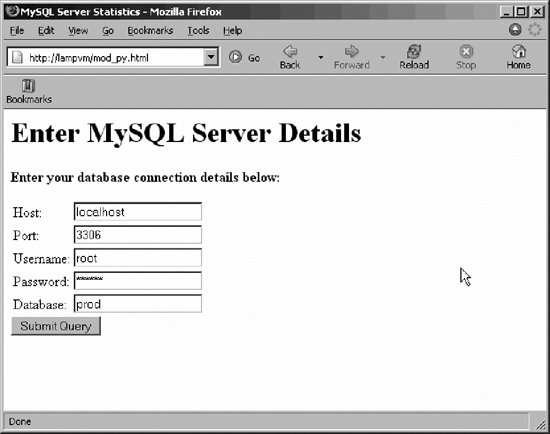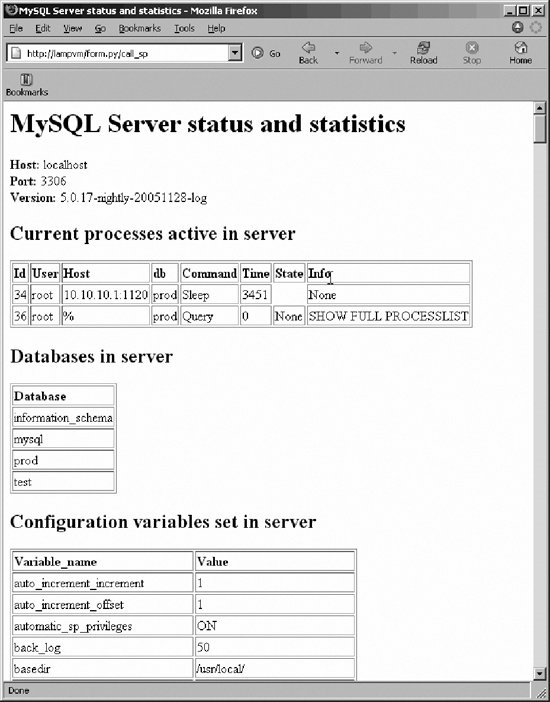A Complete Example
In this section we will present a complete Python program that uses a stored procedure to report on the status and configuration of a MySQL server through a web interface.
The stored procedure we will use is shown in Example 16-29. It takes as an (optional) argument a database name, and reports on the objects within that database as well as a list of users currently connected to the server, server status variables, server configuration variables, and a list of databases contained within the server. It contains one OUT parameter that reports the server version.
Example 16-29. The stored procedure for our complete Python example
CREATE PROCEDURE sp_mysql_info
(in_database VARCHAR(60),
OUT server_version VARCHAR(100))
READS SQL DATA
BEGIN
DECLARE db_count INT;
SELECT @@version
INTO server_version;
SELECT 'Current processes active in server' as table_header;
SHOW full processlist;
SELECT 'Databases in server' as table_header;
SHOW databases;
SELECT 'Configuration variables set in server' as table_header;
SHOW global variables;
SELECT 'Status variables in server' as table_header;
SHOW global status;
SELECT COUNT(*)
INTO db_count
FROM information_schema.schemata s
WHERE schema_name=in_database;
IF (db_count=1) THEN
SELECT CONCAT('Tables in database ',in_database) as table_header;
SELECT table_name
FROM information_schema.tables
WHERE table_schema=in_database;
END IF;
END$$
|
The number and type of result sets is unpredictable, since a list of database objects is generated only if a database matching the stored procedure's first parameter is found on the server.
Prior to every major result set, the stored procedure generates a one-row "title" as a result set. This result set is identified by the column title table_header.
In this example we are going to use the Apache mod_python module to run Python code from within an Apache web page. mod_python allows the Apache web server to run Python code without having to execute an external Python program. You can find out more about downloading and configuring mod_python at http://www.modpython.org.
The HTML part of our web page is shown in Example 16-30. It displays an HTML form that asks for MySQL server connection details, including a database name.
Example 16-30. HTML form for mod_python example
MySQL Server Statistics
Enter MySQL Server Details
Enter your database connection details below:
| Host: | |
| Port: | |
| Username: | |
| Password: | |
| Database: |
|
|
The most important part of this HTML is the action="form.py/call_sp" portion of the FORM tag. This tells Apache that when the form is submitted, the Python program form.py should be executed with the function call_sp() as the entry point. All of the input values of the form are passed to the Python function as arguments.
Figure 16-1 shows the data entry form created by this HTML.
Example 16-31 shows the Python code that is invoked when the user clicks the Submit Query button.
Figure 16-1. mod_python input form

Example 16-31. Python code for our mod_python example
"+ 36 "MySQL Server status and statistics"+ 37 ""+ 38 "
MySQL Server status and statistics
") 39 html_out.append("Host: %s
" % mhost) 40 html_out.append("Port: %s
" % mport) 41 html_out.append("Version: %s
" % mysql_version) 42 html_out.append("".join(html_tables)) 43 44 html_out.append("
There are two main functions in this Python code:
call_sp()
Invokes the stored procedure to generate the MySQL server status report. This is the routine referred to in the action clause of the
tag within the calling HTML.
html_table()
A utility function that creates an HTML table from a MySQLdb cursor result set.
Let's start with the call_sp() routine:
|
Line(s) |
Explanation |
|---|---|
|
812 |
Call the MySQLdb.connect( ) method to create the MySQL connection using the parameters specified on the HTML form. |
|
1415 |
Create and execute a cursor that invokes the stored procedure. |
|
16 |
The WHILE loop that commences on this line will iterate through all of the result sets in the stored procedure. The loop ends on line 27. |
|
1718 |
On line 17 we use fetchall( ) to retrieve all the rows in the current result set. On line 18 we retrieve the column details for that result set. |
|
2022 |
If the title for the first column in the result set is table_header, then this result set contains a heading for a subsequent result set. In that case, we generate an HTML header consisting of the single row and column returned within the result set. |
|
2324 |
Otherwise, create an HTML table to represent the result set. This is done using the other function in the filehtml_table ( )which we will discuss shortly. |
|
2627 |
Request the next result set. If there are no further result sets, we issue break to terminate the loop that commenced on line 16. Otherwise, the loop repeats and we process the next result set. |
|
2932 |
Retrieve the value of the OUT parameter. On line 29 we issue a SELECT to retrieve the user variable that contains the stored procedure OUT variable. When we called the stored procedure on line 15, we specified @server_version for the second (OUT) parameter. Now we issue a SELECT to retrieve the value of that parameter. |
|
3545 |
So far, we have stored HTML that we want to generate into an array called html_tables. Now we construct the final HTML to return to the calling form. Lines 3541 add the initial HTML output into an array html_out. In line 42 we add the HTML generated from the result sets to that HTML. Finally, we return all of the HTML to the calling form on line 45. |
The second functionhtml_table( )generates an HTML table when passed the results of the cursor.description and cursor.fetchall output. We call this in our main program on line 24 when we encounter a result set that we need to format as a HTML table:
|
Line(s) |
Explanation |
|---|---|
|
50 |
The routine takes two arguments. The first (col_desc) is a columns.description structure as returned by the description() method of the cursor object. The second is a results structure as would be returned by the fetchall() method. |
|
5455 |
Loop through the rows in the col_desc parametereach row representing a column in the result setand generate HTML to create a title row for our HTML table. |
|
5760 |
Generate the bulk of the HTML table. The loop on line 57 iterates through the rows in the result set. The loop on line 59 iterates through the columns in a specific row. On line 60 we generate the HTML for a specific value (for a particular column in a particular row). |
|
6364 |
Consolidate all of the HTML fragmentsstored in the html_out array into a single string, which is returned to the calling function. |
Figure 16-2 shows the output from our mod_python example.
Figure 16-2. Output from our mod_python example

Part I: Stored Programming Fundamentals
Introduction to MySQL Stored Programs
- Introduction to MySQL Stored Programs
- What Is a Stored Program?
- A Quick Tour
- Resources for Developers Using Stored Programs
- Some Words of Advice for Developers
- Conclusion
MySQL Stored Programming Tutorial
- MySQL Stored Programming Tutorial
- What You Will Need
- Our First Stored Procedure
- Variables
- Parameters
- Conditional Execution
- Loops
- Dealing with Errors
- Interacting with the Database
- Calling Stored Programs from Stored Programs
- Putting It All Together
- Stored Functions
- Triggers
- Calling a Stored Procedure from PHP
- Conclusion
Language Fundamentals
- Language Fundamentals
- Variables, Literals, Parameters, and Comments
- Operators
- Expressions
- Built-in Functions
- Data Types
- MySQL 5 Strict Mode
- Conclusion
Blocks, Conditional Statements, and Iterative Programming
- Blocks, Conditional Statements, and Iterative Programming
- Block Structure of Stored Programs
- Conditional Control
- Iterative Processing with Loops
- Conclusion
Using SQL in Stored Programming
- Using SQL in Stored Programming
- Using Non-SELECT SQL in Stored Programs
- Using SELECT Statements with an INTO Clause
- Creating and Using Cursors
- Using Unbounded SELECT Statements
- Performing Dynamic SQL with Prepared Statements
- Handling SQL Errors: A Preview
- Conclusion
Error Handling
- Error Handling
- Introduction to Error Handling
- Condition Handlers
- Named Conditions
- Missing SQL:2003 Features
- Putting It All Together
- Handling Stored Program Errors in the Calling Application
- Conclusion
Part II: Stored Program Construction
Creating and Maintaining Stored Programs
- Creating and Maintaining Stored Programs
- Creating Stored Programs
- Editing an Existing Stored Program
- SQL Statements for Managing Stored Programs
- Getting Information About Stored Programs
- Conclusion
Transaction Management
- Transaction Management
- Transactional Support in MySQL
- Defining a Transaction
- Working with Savepoints
- Transactions and Locks
- Transaction Design Guidelines
- Conclusion
MySQL Built-in Functions
- MySQL Built-in Functions
- String Functions
- Numeric Functions
- Date and Time Functions
- Other Functions
- Conclusion
Stored Functions
- Stored Functions
- Creating Stored Functions
- SQL Statements in Stored Functions
- Calling Stored Functions
- Using Stored Functions in SQL
- Conclusion
Triggers
Part III: Using MySQL Stored Programs in Applications
Using MySQL Stored Programs in Applications
- Using MySQL Stored Programs in Applications
- The Pros and Cons of Stored Programs in Modern Applications
- Advantages of Stored Programs
- Disadvantages of Stored Programs
- Calling Stored Programs from Application Code
- Conclusion
Using MySQL Stored Programs with PHP
- Using MySQL Stored Programs with PHP
- Options for Using MySQL with PHP
- Using PHP with the mysqli Extension
- Using MySQL with PHP Data Objects
- Conclusion
Using MySQL Stored Programs with Java
- Using MySQL Stored Programs with Java
- Review of JDBC Basics
- Using Stored Programs in JDBC
- Stored Programs and J2EE Applications
- Using Stored Procedures with Hibernate
- Using Stored Procedures with Spring
- Conclusion
Using MySQL Stored Programs with Perl
- Using MySQL Stored Programs with Perl
- Review of Perl DBD::mysql Basics
- Executing Stored Programs with DBD::mysql
- Conclusion
Using MySQL Stored Programs with Python
- Using MySQL Stored Programs with Python
- Installing the MySQLdb Extension
- MySQLdb Basics
- Using Stored Programs with MySQLdb
- A Complete Example
- Conclusion
Using MySQL Stored Programs with .NET
- Using MySQL Stored Programs with .NET
- Review of ADO.NET Basics
- Using Stored Programs in ADO.NET
- Using Stored Programs in ASP.NET
- Conclusion
Part IV: Optimizing Stored Programs
Stored Program Security
- Stored Program Security
- Permissions Required for Stored Programs
- Execution Mode Options for Stored Programs
- Stored Programs and Code Injection
- Conclusion
Tuning Stored Programs and Their SQL
- Tuning Stored Programs and Their SQL
- Why SQL Tuning Is So Important
- How MySQL Processes SQL
- SQL Tuning Statements and Practices
- About the Upcoming Examples
- Conclusion
Basic SQL Tuning
Advanced SQL Tuning
- Advanced SQL Tuning
- Tuning Subqueries
- Tuning Anti-Joins Using Subqueries
- Tuning Subqueries in the FROM Clause
- Tuning ORDER and GROUP BY
- Tuning DML (INSERT, UPDATE, DELETE)
- Conclusion
Optimizing Stored Program Code
- Optimizing Stored Program Code
- Performance Characteristics of Stored Programs
- How Fast Is the Stored Program Language?
- Reducing Network Traffic with Stored Programs
- Stored Programs as an Alternative to Expensive SQL
- Optimizing Loops
- IF and CASE Statements
- Recursion
- Cursors
- Trigger Overhead
- Conclusion
Best Practices in MySQL Stored Program Development
EAN: 2147483647
Pages: 208
